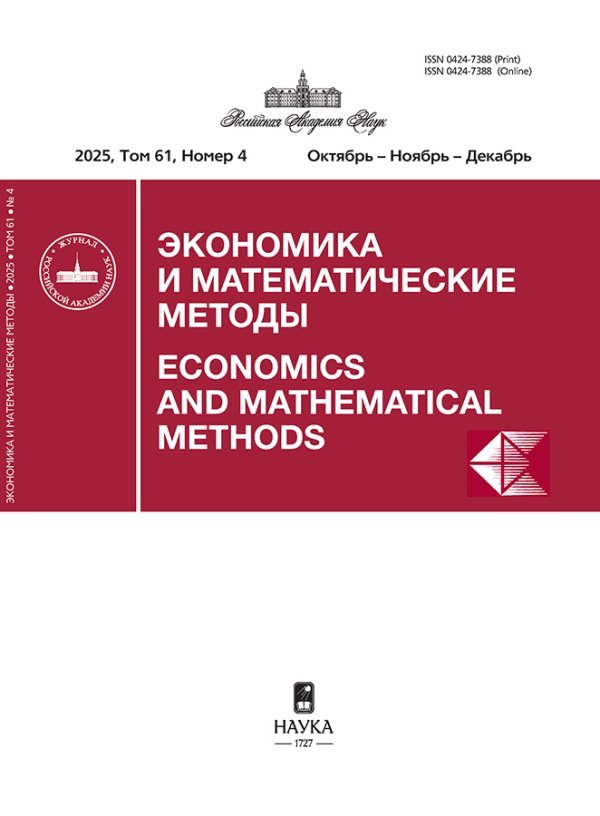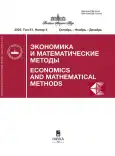Quantile XGBoost and SHAP in Creating and Explaining Forecasting Models for AI Tokens
- Authors: Kucherov I.I.1
-
Affiliations:
- Centre for Financial Research, Data Analytics, HSE University
- Issue: Vol 61, No 4 (2025)
- Pages: 111-125
- Section: Mathematical analysis of economic models
- URL: https://stomuniver.ru/0424-7388/article/view/697034
- DOI: https://doi.org/10.31857/S0424738825040099
- ID: 697034
Cite item
Abstract
This research aims to develop a model and methodology for forecasting logarithmic returns (logreturns) for a new asset class of AI (Artificial Intelligence) tokens. To obtain one day ahead forecasts for the 0.9, 0.5, and 0.1 quantiles, the use of XGBoost quantile models is proposed, which represent an ensemble, based on gradient boosted regression trees. Quantile models have an advantage in terms of forecasting over traditionally used regression models because they allow for the estimation of not only point forecasts but also of their confidence intervals, while remaining robust to outliers. This is especially important when forming the forecasts for various cryptocurrencies’ market characteristics, which are known to be highly volatile. In addition to forecasting, the study conducts a post-forecast analysis using the SHAP (Shapley Additive explanations) method, which allows to interpret the XGBoost model, revealing key factors that are important for forecasting AI tokens’ logreturns. Based on the results of feature importance analysis with SHAP, a significant influence of AI stocks’ market characteristics, cryptocurrency market investor sentiment, seasonal fluctuations, as well as features related to the Blockchain ecosystem was identified. The paper also discusses and addresses the shortcomings of modern forecasting and post-forecasting analysis approaches for time series in general. The obtained results, in addition to academic interest, are relevant for private investors, risk managers, firms and regulators.
Keywords
About the authors
I. I. Kucherov
Centre for Financial Research, Data Analytics, HSE University
Email: unequivocally.ivan@gmail.com
Moscow, Russia
References
- Abdullah M., Sarker P. K., Abakah E. J. A., Tiwari A. K., Rehman M. Z. (2024). Tail risk intersection between tech-tokens and tech-stocks. Global Finance Journal, 61, 100989. doi: 10.1016/j.gfj.2024.100989
- Adekoya O. B., Oliyide J. A., Saleem O., Adeoye H. A. (2022). Asymmetric connectedness between Google-based investor attention and the fourth industrial revolution assets: The case of FinTech and Robotics, Artificial intelligence stocks. Technology in Society, 68, 101925. doi: 10.1016/j.techsoc.2022.101925
- Akpan M. (2024). Attention is all you need: An analysis of the valuation of artificial intelligence tokens. SSRN: 4993784. doi: 10.2139/ssrn.4993784
- Ali R., Xu J., Baig M. H., Rehman H. S.U., Waqas Aslam M., Qasim K. U. (2024). From data to decisions: enhancing financial forecasts with LSTM for AI token prices. Journal of Economic Studies, 51 (8), 1677–1693. doi: 10.1108/JES-01-2024-0022
- Ali S., Al-Nassar N.S., Khalid A. A., Salloum C. (2024). dynamic tail risk connectedness between artificial intelligence and fintech stocks. Annals of Operations Research, 1–35. doi: 10.1007/s10479-024-06349-y
- Ante L., Demir E. (2024). The ChatGPT effect on AI-themed cryptocurrencies. Economics and Business Letters, 13 (1), 29–38. doi: 10.2139/ssrn.4350557
- Baklanova V., Kurkin A., Teplova T. (2024). Investor sentiment and the NFT hype index: To buy or not to buy? China Finance Review International, 14 (3), 522–548. doi: 10.1108/CFRI-06-2023-0175
- Bao T., Wang X., Mahdavi N., McCarthy C., Rezazadegan D. (2023). Dynamic XGBoost-based quantile predictor for real-time electricity price forecasting. In: 2023 IEEE International Conference on Energy Technologies for Future Grids (ETFG), 1–6). IEEE. doi: 10.1109/ETFG55873.2023.10407379
- Blom H. M., Lange P. E. de, Risstad M. (2023). Estimating value-at-risk in the EURUSD currency cross from implied volatilities using machine learning methods and quantile regression. Journal of Risk and Financial Management, 16 (7), 312. doi: 10.3390/jrfm16070312
- Bonaparte Y. (2024). Artificial intelligence in finance: Valuations and opportunities. Finance Research Letters, 60, 104851. doi: 10.1016/j.frl.2023.104851
- Chen T., Guestrin C. (2016). Xgboost: A scalable tree boosting system. In: Proceedings of the 22nd acm sigkdd international conference on knowledge discovery and data mining, 785–794. doi: 10.1145/2939672.2939785
- Hafid A., Ebrahim M., Rahouti M., Oliveira D. (2024). Cryptocurrency price forecasting using XGBoost regressor and technical indicators. In: 2024 IEEE international performance, computing, and communications conference (IPCCC), 1–6. IEEE. doi: 10.1109/IPCCC59868.2024.10850357
- Hossain S., Kaur G. (2024). Stock market prediction: XGBoost and LSTM comparative analysis. In: 2024 3rd International conference on artificial intelligence for internet of things (AIIoT), 1–6. IEEE. doi: 10.1109/AIIoT58432.2024.10574794
- Jabeur S. B., Mefteh-Wali S., Viviani J. L. (2024). Forecasting gold price with the XGBoost algorithm and SHAP interaction values. Annals of Operations Research, 334 (1), 679–699. doi: 10.1007/s10479-021-04187-w
- Jamieson K., Talwalkar A. (2016). Non-stochastic best arm identification and hyperparameter optimization. In: Artificial intelligence and statistics, 240–248. PMLR. doi: 10.48550/arXiv.1502.07943
- Jareño F., Yousaf I. (2023). Artificial intelligence-based tokens: Fresh evidence of connectedness with artificial intelligence-based equities. International Review of Financial Analysis, 89, 102826. doi: 10.1016/j.irfa.2023.102826
- Kumar K. S., Sree D. I., Devi P. Y., Pujitha M. V. (2024, June). Comparative analysis of LSTM and XGBoost models for short-term bitcoin price prediction. In: 2024 3rd International Conference on Applied Artificial Intelligence and Computing (ICAAIC), 932–939). IEEE. doi: 10.1109/ICAAIC60222.2024.10575848
- Lu Y. H., Lin Y. C. (2024). The determinants of voluntary disclosure: Integration of eXtreme gradient boost (XGBoost) and explainable artificial intelligence (XAI) techniques. International Review of Financial Analysis, 96, 103577. doi: 10.1016/j.irfa.2024.103577
- Lundberg S. M., Lee S. I. (2017). A unified approach to interpreting model predictions. Advances in Neural Information Processing Systems, 30. doi: 10.48550/arXiv.1705.07874
- Ma C. Q., Liu X., Klein T., Ren Y. S. (2025). Decoding the nexus: How fintech and ai stocks drive the future of sustainable finance. International Review of Economics & Finance, 103877. doi: 10.1016/j.iref.2025.103877
- Malik F., Umar Z. (2024). Quantile connectedness of artificial intelligence tokens with the energy sector. Review of Financial Economics. John Wiley & Sons, 43 (2), 135–146. doi: 10.1002/rfe.1224
- Oukhouya H., Kadiri H., El Himdi K., Guerbaz R. (2024). Forecasting international stock market trends: XGBoost, LSTM, LSTM–XGBoost, and Backtesting XGBoost models. Statistics, Optimization & Information Computing, 12 (1), 200–209. doi: 10.19139/soic-2310-5070-1822
- Pedregosa F., Varoquaux G., Gramfort A., Michel V., Thirion B., Grisel O. et al. (2011). Scikit-learn: Machine learning in Python. The Journal of Machine Learning Research, 12, 2825–2830. doi: 10.48550/arXiv.1201.0490
- Shahzad U., Asl M. G., Panait M., Sarker T., Apostu S. A. (2023). Emerging interaction of artificial intelligence with basic materials and oil & gas companies: A comparative look at the Islamic vs. conventional markets. Resources Policy, 80, 103197. doi: 10.1016/j.resourpol.2022.103197
- Smelyakov K., Klochko O., Dudar Z. (2023). Building quantile regression models for predicting traffic flow. COLINS, 1, 117–132. DOI: https://ceur-ws.org/Vol-3387/paper10.pdf
- Somkunwar R. K., Pimpalkar A., Srivastava V. (2024). A novel approach for accurate stock market forecasting by integrating ARIMA and XGBoost. In: 2024 IEEE International students’ conference on electrical, electronics and computer science (SCEECS), 1–6. IEEE. doi: 10.1109/SCEECS61402.2024.10481891
- Trabelsi Karoui A., Sayari S., Dammak W., Jeribi A. (2024). Unveiling outperformance: A portfolio analysis of top AI-related stocks against it indices and robotics ETFs. Risks, 12 (3), 52. doi: 10.3390/risks12030052
- Vaka S., Reddy M. S., Prabhu S. N. (2024). Hybrid model for cryptocurrency price prediction using Lstm, bidirectional LSTM, and XGBoost. In: 2024 International conference on IoT based control networks and intelligent systems (ICICNIS), 925–932. IEEE. doi: 10.1109/ICICNIS64247.2024.10823223
- Xiaoyang X., Ali S., Naveed M. (2024). Artificial intelligence and big data tokens: Where cognition unites, herding patterns take flight. Research in International Business and Finance, 72, 102506. doi: 10.1016/j.ribaf.2024.102506
- Yadav M. P., Abedin M. Z., Sinha N., Arya V. (2024). Uncovering dynamic connectedness of Artificial intelligence stocks with agri-commodity market in wake of COVID-19 and Russia-Ukraine Invasion. Research in International Business and Finance, 67, 102146. doi: 10.1016/j.ribaf.2023.102146
- Yousaf I., Ijaz M. S., Umar M., Li Y. (2024). Exploring volatility interconnections between AI tokens, AI stocks, and fossil fuel markets: evidence from time and frequency-based connectedness analysis. Energy Economics, 133, 107490. doi: 10.1016/j.eneco.2024.107490
- Yousaf I., Youssef M., Goodell J. W. (2024). Tail connectedness between artificial intelligence tokens, artificial intelligence ETFs, and traditional asset classes. Journal of International Financial Markets, Institutions and Money, 91, 101929. doi: 10.1016/j.intfin.2023.101929
- Yu H., Wang L., Jiang S., Zhang C., Li J., Hu T. (2023). Ultra-short-term operating reserve requirement assessment of power system based on improved XGboost quantile regression. In: 2023 2nd Asia power and electrical technology conference (APET), 756–760. IEEE. doi: 10.1109/APET59977.2023.10489014
Supplementary files











